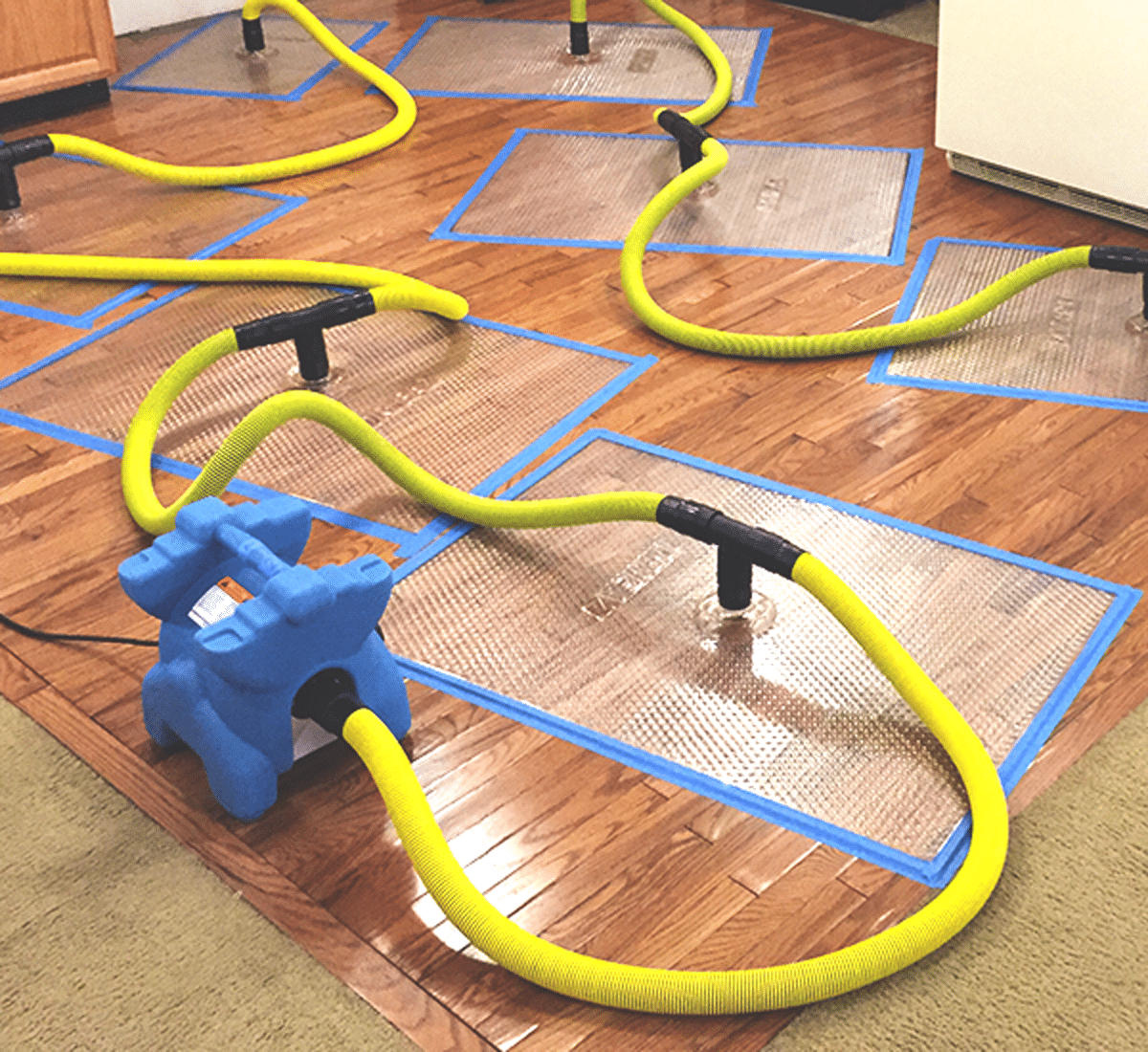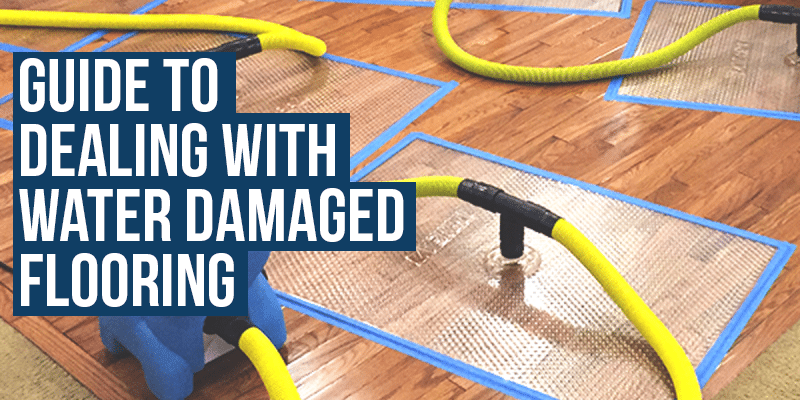In this article we will be covering one of the most common types of property damage that we see….
Water Damaged Flooring.
How can flooring get water damaged you may ask?
Well there are countless ways in which water can spill onto your floor but some common ones include:
overflows from sinks and toilets, appliance leaks such as dishwashers and washing machines, and of course broken pipes all seeping into your hardwood floors.
Now, the first thing somebody with water damaged flooring asks is….
Can my water damage flooring be restored or does it have to be replaced?
This is one of the most common questions we get asked whenever we encounter wet flooring. Water damaged flooring can occur from dishwasher leaks, washing machine leaks, toilet overflows, shower overflows, sink overflows, sink backups, pipe bursts or any other standing water that affects your flooring.
So, can we restore your floors or do you need to replace them?
That is what we’ll aim to answer for you,
So whether you have water damaged carpeting, water damaged laminate, water damaged engineered hardwood, or even wet solid hardwood floors, this article will help you understand and give you the information you need to better assess your current situation.
Before we get into it we want to quickly address a basic principle, and that is..
The Difference
Between Standing Surface Water
And Bound Water

Standing surface water / Free Water
Standing surface water is all the visible water you can that still resides in your home after a flood. Anything that you can clean up with your towels and Shop-Vacs resulting from a seemingly dry floor can be categorized as standing water.
This can be sourced from tap overflows, shower overflows, or other sources that leaks that have an excess amount of water.
Bound water
Bound water is the trickier part. This is water that has been absorbed into the material (carpet, hardwood floors, laminate, etc.) and is much more difficult to dry.
Bound water is what most people don’t see and is the main cause of damage to your hardwood flooring.
For example, if your toilet overflowed onto nearby hardwood floors, you cleaned it up with some towels and everything looks fine so you continue on with your day.
However, leftover moisture will absorb into your hardwood flooring and cause additional damage over time.
A day or two later, you begin to notice ripples or dark edges on your hardwood flooring,
Which is what bound water will do to the material if not dried properly and promptly.
Ok, so let’s get started:
Dealing with
Water Damaged
Flooring
Wet Carpeting
For the most part, wet carpeting is restorable, however,
You will need to remove all the water you can out of it and dry it as soon as possible.
But also,
Keep in mind that the carpet underlay (cushion, or carpet pad) will also be wet and many people make the mistake of removing the water from the actual carpet while leaving the underlay soaking wet.
As days go by, if the carpet starts staining and there is an unpleasant smell coming from the area,
This is the result of not removing all the excess water and drying the areas fast enough.
When drying, make sure you follow the four principles to make sure you’re drying properly.
So when it comes to carpet underlay try to remove as much water as you can out of it.
This may prove to be difficult since the material is sponge-like and loves to soak up water.
The other option you have is to simply cut out the wet underlay and dispose of it, replacing it with similar carpet underlay will be required once the areas are dry.
If you want to know how to dry a wet carpet, click here.
De-laminating Carpets
If acted upon quickly carpeting can be saved by prompt drying, however, if the carpeting is left wet for longer periods of time it can start to de-laminate (break-down).
When the glue that holds the layers of carpeting starts to dissolve,
you will notice a sand-like substance falling off the carpeting.
Once the carpet is de-laminated it is in theory in its dying days will likely not hold together for much longer, and thus possibly requiring replacement.
Once the carpet is de-laminated you may see the following effects:
- a wavy or rippling effect to the way the carpeting looks
- shedding of fibers
- carpet seams start to release (seams that connect the carpeting from a hallway to a bedroom door, this is a common place for a carpet seam)
Wet Laminate and Wet Engineered Flooring
Although the quality of these two wood floors can greatly differ we are going to be grouping them into the same category and we will explain why shortly.
Laminate Flooring:
Usually the cheapest type of hard-wood type flooring choices.
Laminate Flooring is made of lower quality materials into thin-medium density tiles.
The surface typically made of a plastic/paper type material.
Engineered Hardwood Flooring:
Made of medium-thick density and can be made of great quality with real wood layers.
Nowadays this is one of the most popular flooring choices and can be found in new condo and apartment buildings.
Both laminate and engineered hardwood flooring can be resistant to surface water spillage.
If cleaned up quickly enough, minimal surface damage will occur.
The engineered hardwood can withstand more abuse since it’s better constructed.
Now the answer to your question!
Can Laminate Or
Engineered Flooring Be Restored
If Damaged By Water?
The answer, for the most part, is, NO (depending on how much water has affected the floor of course)
If enough water has spilt on your engineered or laminate floor it will begin to seep through the joints and through the edges of the walls, and thus getting underneath the flooring. If water has gotten underneath the flooring then it will likely not be restorable.
Why?
The reason for this is the lack of air-flow or drying that can be applied under the floor.
Thus it simply will not dry fast enough on its own.

The water beneath will soak into the flooring material and you will start to see the surface damage such as cupping.
Engineered and laminate flooring is commonly installed with a
vapor barrier or cushion underneath it.
This vapor barrier is like a plastic sheeting that makes it very difficult for water to evaporate and it ends up just getting trapped.
There is little even a professional restorer can do to restore these flooring types, mainly due to the vapor barrier beneath the flooring, as no drying method would be effective on it.
Of course, this will depend on how severe your water damage situation is if it’s just a small puddle or spillage….
Then there is no need to start ripping up your flooring.
However, if the water is squishing out of the edges of the floor when you walk on it then it is more than likely you will be needing a floor replacement.
Can Hardwood
Flooring Be Restored If
Damaged By Water?
When it comes to wet hardwood flooring (solid hardwood) the answer is YES, the flooring can be restored after being water damaged.
Solid hardwood flooring as you may have guessed is made of solid hardwood throughout and is made with a special set of grooves underneath it, called flutes.
These grooves allow for the wood to naturally expand and contract, they also enable airflow movement underneath the flooring.

Which allows for the professional restorer to dry the flooring properly.
Through the use of specialty drying equipment such as the “dri-eaz mat drying system” a property restoration company can save and restore your expensive hardwood floor.
Once the moisture levels in the hardwood have been restored back to acceptable levels….
You can begin to repair or refinish any surface damages that may have occurred during the flooding.
So there you have it, now you know what to expect when you find yourself with water damaged flooring. The trick is always to act quickly and clean up any water mess as soon as possible so that it doesn’t soak in and spread further than it has to! The longer we wait, the more difficult it becomes to dry your flooring without any bacterial growth.
If you need water damage repair or restoration on your hardwood, laminate or engineered hardwood flooring, make sure to contact a reputable water damage restoration company to help dry your floors.
Serving Vancouver residents since 1993, Incredible Restorations offers a complete suite of property restoration and cleanup services from flood, water, fire, smoke, wind, and storm.

